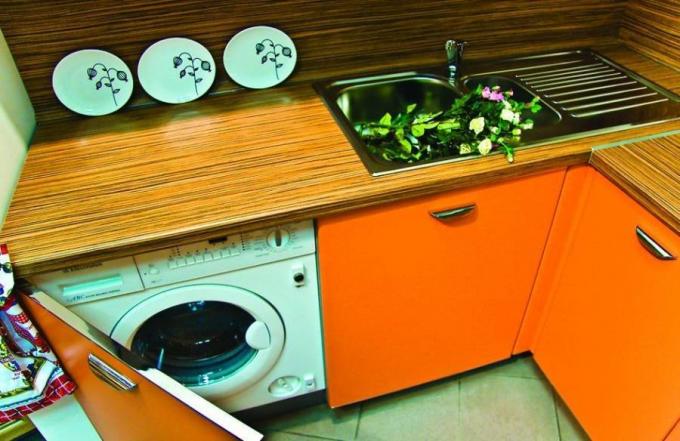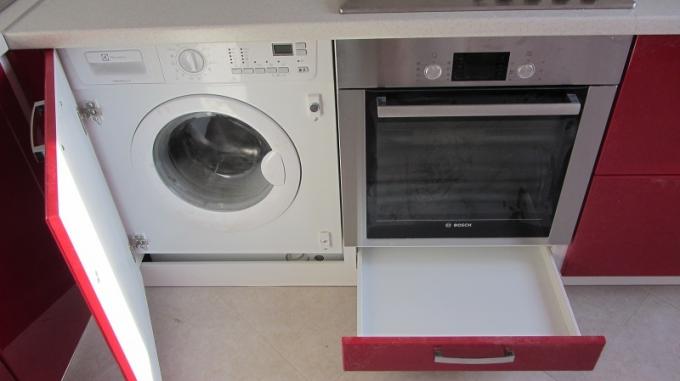Content
-
1 Washing machine in the kitchen - excellent or impractical
- 1.1 Positive and negative sides
- 1.2 Choosing a unit
-
2 We mount the machine with our own hands
- 2.1 Washing machine connection
- 2.2 We connect to the water supply
- 2.3 Align position using a level
- 3 Summarizing
For several decades in a row, housewives have simply dreamed of this household appliance. Yes, yes, we will now talk about a washing machine, which is in almost every Russian family. The overwhelming number of models of these devices are a stand-alone unit operating from the network power supply, but we are not talking about them - a washing machine built into the kitchen, this is what the owners of small apartments!

Washing machine built into the niche
Washing machine in the kitchen - excellent or impractical
Kitchens with built-in washing machine Is a fairly new phenomenon in our country. Someone thinks such a solution is an excellent option, someone is skeptical about all design decisions and considers this option unacceptable. Let's figure it out.
Most often, you can find a washing machine in the kitchen in small apartments. Why? It's simple - sometimes the bathrooms are so tiny that there is simply nowhere to put the unit. But despite the compressed parameters of the apartment, the designers still found a way out - to install the typewriter in the kitchen set under the countertop. This type of work can be called quite simple, so most men do it with their own hands.
Positive and negative sides
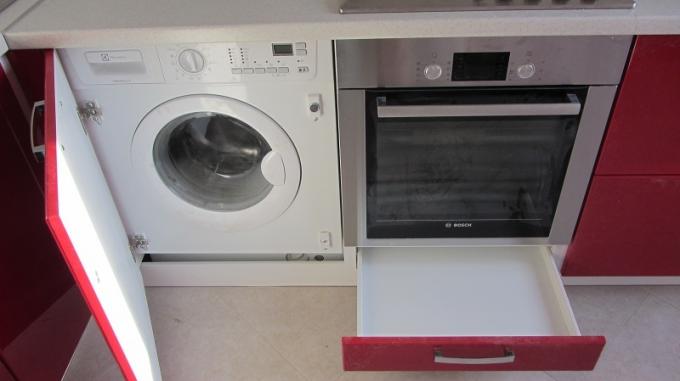
Built-in household kitchen appliances
There is no consensus on this matter and only those who have this household appliance installed in the kitchen room can draw a conclusion. Now we will consider the main positive features and disadvantages of such a placement, so that later we can draw the correct conclusion with a clear conscience.
As always, let's start with the pros:
- More free space. By mounting the washing machine under the countertop and closing it with doors, you can save about 1 m², which is quite a weighty figure in cramped conditions;
- Convenience of installation and connection. Due to its close location to communications and special adapters, the washing machine can be placed next to the sink - now you will not be disturbed by protruding hoses and pipes;
- Possibility of a wide choice. Now, when the washing machine is installed in a kitchen set, you can choose any model, even with a depth of 60 cm or more (it all depends on the place where the machine will be installed).
Disadvantages:
- In general, according to the rules for using this household appliance, the door must be left open after washing. This circumstance in a kitchen is not only not practical, but also not aesthetically pleasing;
- The washing machine in the bathroom can serve as a great place to store dirty linen, but this will not work in the kitchen (linen that has been in the wash for a long time starts to smell not very pleasant);
- And finally, the last thing - food and household chemicals (washing powder, air conditioner, water softeners, etc.) are not the best combination, because even if the powder is carefully poured into the machine tray, small particles will rise into the air and settle on food.
Choosing a unit

Built-in machine Teka LI4 1080E
Before answering the question - how to build a washing machine into kitchen furniture, consider such an aspect as the choice of a suitable unit.
- Built-in models of machines do not have a very attractive look, compared to free-standing washing units, but in our case this is not a mandatory criterion. As a rule, most buyers are confused about the fasteners that are located on the right and left on the front side. They are intended for fastening a decorative door, adapted to your kitchen set.
- In most cases, built-in washing machines are hidden under the kitchen countertop and covered with doors. Before purchasing a new unit, check the dimensions of your kitchen - perhaps the model you like will simply not fit into the niche intended for it. As a rule, washing units have a standard size - depth 57 cm, width - 60 cm, height - 85 cm, so you are unlikely to have problems.
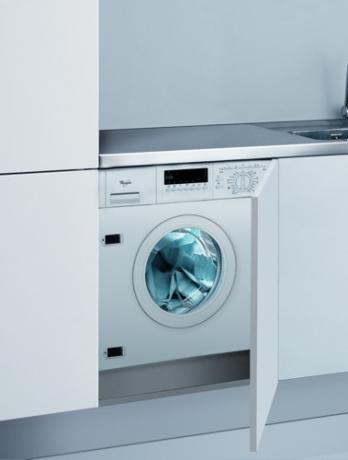
Perfectly matched unit for the size of the kitchen set
Note! The model you have chosen must be adapted to the Russian operating conditions (tolerate short circuits, power surges and sudden power outages).
- If you buy not a domestic, but an imported model, then on the insert of the product there should be a marking "EEC Criteria", in which it is mandatory to indicate the characteristics of the machine that meet all European standards quality.
- As for consumer indicators, built-in and free-standing machines are completely identical. The price for built-in models is slightly lower than for free-standing ones, but this criterion does not say anything - you can often find a built-in model, which is several times more expensive than a stand-alone unit of an average cost.
We mount the machine with our own hands

Typewriter installed under the tabletop headset
As practice has shown, built-in household appliances are extremely popular among all segments of the population: they fit perfectly into any interior, help save space, and are just convenient. In addition, the built-in units "hide" behind the facades of the kitchen, not even in a dream, not reminding them of their presence.
In order to integrate the washing machine into the kitchen, you will need the following tool:
- Kitchen Cabinet;
- Roulette;
- Table top;
- Fasteners and fittings;
- Screwdrivers, screwdriver, possibly a drill, jigsaw and other carpentry tools.
To begin with, choose the type of machine - if you want to completely hide the "washing machine" from prying eyes, then you need to make a choice in favor of a fully built-in model. Not everyone can afford such a unit, but in order to turn the kitchen into a real culinary workshop without unnecessary units, you will have to spend a little. On such models it is necessary to attach a special door that can be opened from both the left and right sides.
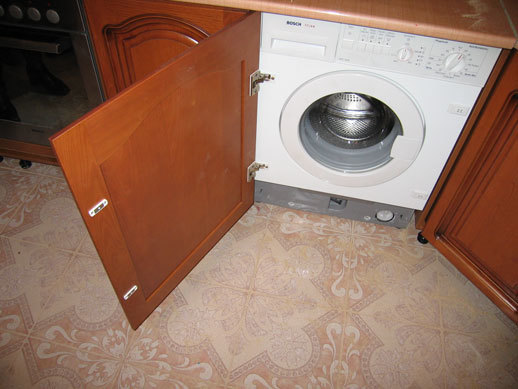
Door fixing example
Also, you can pay attention to models with a front-mounted loading compartment (top covered with a table top). In such units, the cover can be removed, with further replacement with a tabletop element. In most cases, built-in models are height-adjustable by raising the legs, so it is unlikely that you will not be able to shove the machine into the headset. As you can see installing a washing machine in the kitchen is an everyday matter.
Owners of small apartments with small kitchens can purchase narrow built-in machines. Such models are in no way inferior in performance and functionality, but they have much smaller dimensions. There is only one "but" - the drum rotation speed on such units is somewhat lower, and the cost, in contrast to the "full" models, is higher.
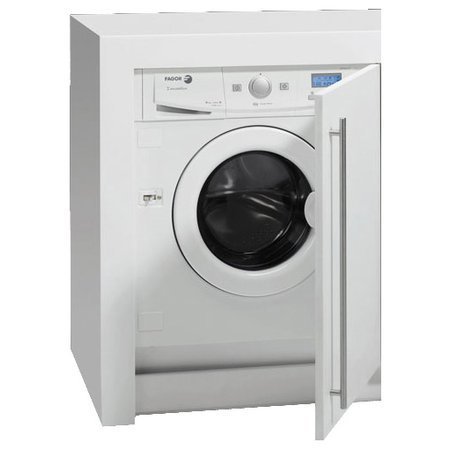
Narrow model Fagor 3FS-3611IT
Place the built-in unit under the worktop. But remember that some models can be difficult. For example, it often happens that the compartment for filling the powder simply does not open, as it is pressed against by the wall or tabletop. What to do? Most people just pour the powder into the drum - the operating instructions do not prohibit this and this does not affect the quality of washing.
In order to close the washing machine inside the cabinet, it is necessary to shove the device deeper under the visor and install the door. A closed door will completely hide your car from prying eyes. Note that you will need to open both the cabinet door and the compartment door to load the laundry into the drum.
Washing machine connection
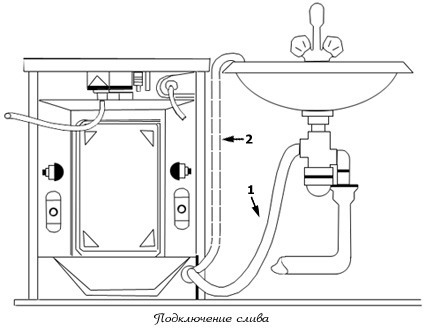
Drain connection
The washing machine built into the kitchen, like any other unit, requires a connection. Connection is not only to plug the plug into the outlet, but also to equip a water intake and drainage system.
The connection of the above unit must take into account several features:
- Devices that are not equipped with a special non-return valve that allows water to flow in only one direction cannot be installed without indicating the level of the outlet hose;
- In order to connect the washing machine directly to the sewer, you need to purchase an additional siphon. The hose itself coming from the unit is securely connected to the drain pipe coming from the sink. With this connection, leaks are completely excluded;
- Quite often, people simply attach the drain pipe to the side of the sink, but this method is not reliable and safe.
Advice! The most acceptable option for connecting the washing machine to the sewer is the installation of a stationary drain.
- After installing the unit, it is necessary to check if the branch pipe is straightened. It must be rigidly fixed along the entire length without kinks. If you decide to lengthen the hose, it is recommended to use special clamps to secure the connections.
We connect to the water supply
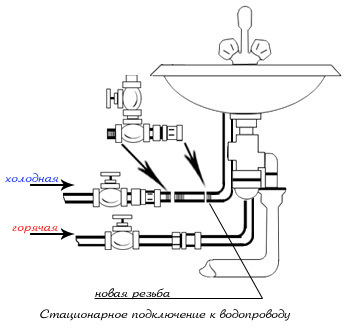
Connection diagram of the machine to the water supply
After you figured out how to connect the pipe to the sewer, it's time to move on to connecting the system to the water supply:
- For this, flexible hoses with a diameter of ¾ "are used;
- We mount a special valve to the water supply pipe (cold water), which closes after each wash;
- To supply water, it is customary to use special taps that come from the mixer (tees or branch pipes);
- The tee itself is attached to the cold water pipe, and the hose from the washing machine and the hose from the mixer are already connected to it. That's basically it.
Advice! Do not neglect the use of fum tape or tow.
Align position using a level
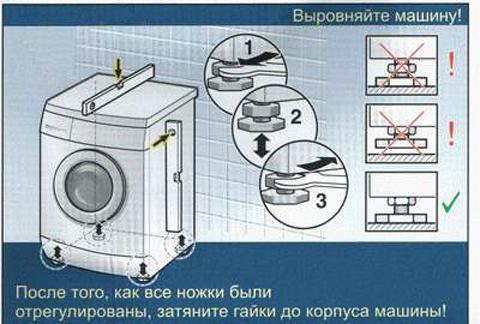
Washing machine regulation
In order to keep vibration to a minimum, the machine must be level. For this, each product has adjustable legs. If not available, thick rubber inserts can be used.
Next, we check the stability of the device - if the machine shakes even a little, you will have to adjust the system again using the building water level. The machine must stand firmly.
Summarizing
That's basically all a home craftsman needs to know. Kitchens with a built-in washing machine are certainly a new phenomenon, but in terms of their design features and connection method, they practically do not differ from standard and familiar models. If you still have questions or want to clarify some aspects, our photo and video material will help you with this (read also about where is the best place to hang the kitchen TV).
